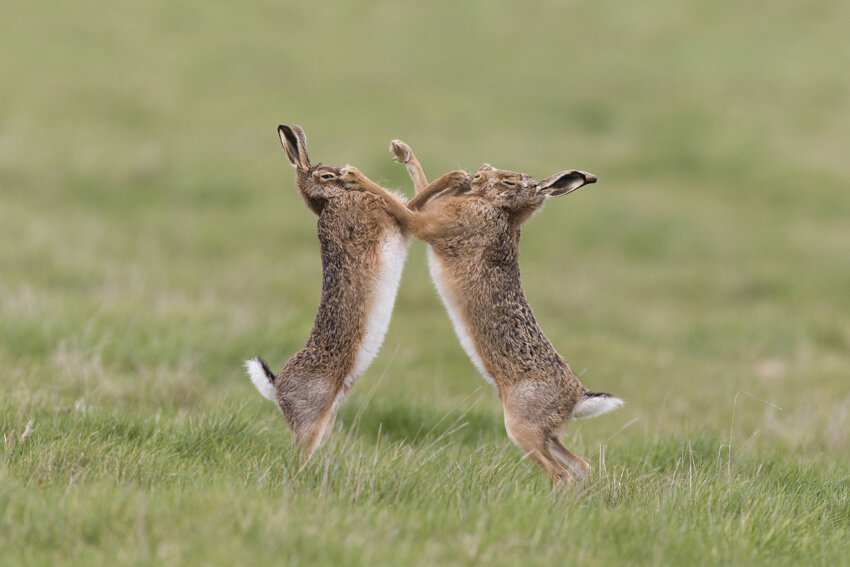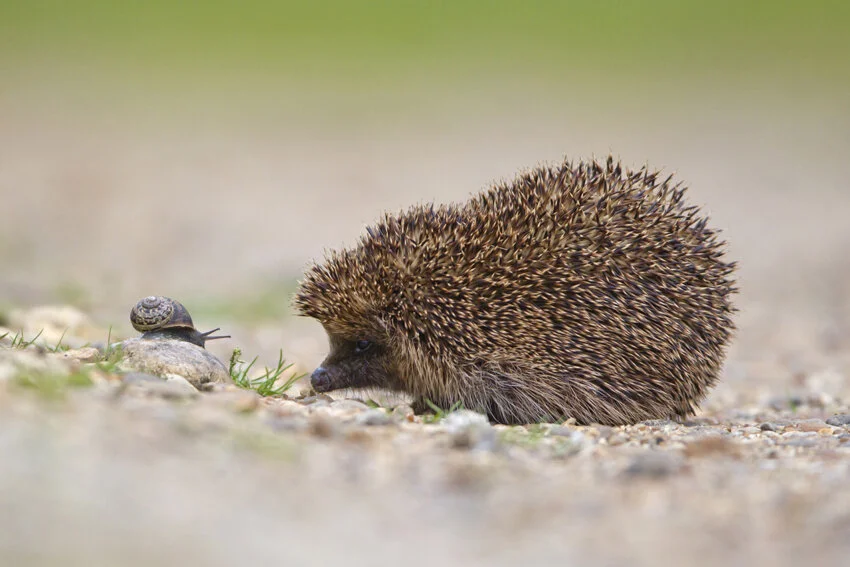We asked Paul Sawer, a local Wildlife Photographer who runs our popular Photography Courses, to share some of his experiences with us. Here’s what he had to say:
Can you tell us a bit about yourself?
I am 49, live in Saxmundham, Suffolk and I am a professional wildlife photographer.
My job allows me to travel widely and I arrange and guide wildlife photography tours as well as teaching and setting up photographic experiences in the UK including photo tuition at SOS.
Boxing Hares - photo by Paul Sawer
What led to you becoming a wildlife photographer?
I have held a passion for the countryside and it’s wildlife since childhood. In the early years I was content to simply observe the local wildlife but in my twenties I wanted to record what I was seeing on film (stills not movie), hoping to emulate some of the great images that were being published at that time. This was to prove a very slow process and it took me years until I had reached the standard I was aiming for. This was not only due to having to learn the camera and the art of photography but also learning about the subject itself. For me the latter was the fun part. I am not into landscapes, portraiture or still life and I would not be a photographer if there wasn’t any wildlife to point the camera at.
Once I had attained a decent standard I was able to provide a little income through image sales via photographic agencies although my main revenue nowadays comes from workshops I conduct assisting other photographers to obtain quality imagery.
Kestrel - photo by Paul Sawer
How has wildlife photography changed over the years?
The main change has been the development of digital camera technology. Not only can one now take many more frames per second (any extra frame offers more chance that a fast moving subject will be captured in the correct position) but the advancements in high ISO mean that even on the darkest days a high shutter speed (therefore avoiding motion blur) can be obtained without too much loss of image quality. High capacity memory cards mean you can shoot many 1000’s of shots without the expense or concern of changing film after 36 shots so consequently the chances of obtaining good results are higher.
Another great advantage is the ability to immediately view the resulting images alongside the shooting data. This is a huge benefit to the photographer and also extremely helpful when I am offering tuition.
There are now several folk like myself around the country that provide services such as hide hire or specialist photo experiences where all the groundwork has been done to, as far as is possible with wild subjects, almost guarantee your chosen animal will arrive on cue.
Tawny Owl - photo by Paul Sawer
Is being a successful photographer down to equipment, skills or luck, or a combination of all three?
All three for sure, with the addition of knowledge and experience, though these may come under skills.
Knowing what to expect and the exact spot, where say a bird will settle, enables me to be set up and be ready to press the shutter at the right time. My general style is for a ‘clean’ image without any distracting elements and I often create a scene in which I have complete control of everything apart from the bird to ensure the foreground, background, lighting, distance from subject etc. are all as I desire and then wait for the bird to appear in my chosen spot. A little bait usually helps in achieving this fairly quickly
As previously mentioned the equipment available today is incredible but I feel this simply means one has to up their game to create images that stand out, which is by no means a bad thing.
There is of course still plenty for the photographer to do. One still has to constantly adjust settings, expose, focus, track and compose as well as battle the elements and often undertake some ungodly alarm calls.
No doubt luck comes into play occasionally but I feel you usually make your own luck or rather increase your chances. Experience teaches you to leave the camera turned to certain settings so that it is ready to go for that moment a hawk comes whizzing past, when there simply isn’t time to make any camera setting adjustments. Or on a cloudy day setting your hide in the position that still works should the sun appear.
Barn Owl and Butterfly - photo by Paul Sawer
What is your best/ most memorable photo that you've taken/ that someone else has taken? (And can you share them?)
In my formative years I was inspired by two photographers.
Eric Hosking began photography in the 1920’s and was way ahead of his time producing some incredible shots and I can only wonder what he would have achieved given today’s equipment.
Eric Hosking setting up an automatic trip for use with High Speed Flash to Photograph birds in flight -1948 (Photo courtesy of the Eric Hosking Trust)
2 images, 1 of a barn owl and the other a nightjar, both in flight, stand out as favourites.
Stephen Dalton produced some amazing images using high speed flash in 1970’s and 80’s (and probably still does). His work mostly involved insects but his shot of a swallow drinking blew me away when I first saw it and I would be thrilled to have taken it myself. Again this was with ‘old’ technology which makes the achievement even more amazing and, although still difficult, would be much easier to capture today.
Photo of a Swallow drinking, by Stephen Dalton
I don’t have a favourite photo of my own work. I feel it is a bit like food or music and depends on my mood. I do however have favourite subjects- kingfishers top the list followed closely by owls, birds of prey and hares. I like simple uncluttered shots usually with an element of action.
Kingfisher with catch - photo by Paul Sawer
What is one bit of advice you'd give everyone to help wildlife?
Start at home. It doesn’t have to be much. I feel something we can all do fairly easily is to leave a little area of the garden wild.
Plant some wildflower seeds, build a nest box or dig a pond.
If everyone has just a little bit for nature this turns a housing estate into a nature reserve with little refuges dotted around at regular intervals.
Hedgehog and Snail - photo by Paul Sawer
To see more of Paul’s images and find details of his photography courses, please visit his website:
www.paulsawer.co.uk
To find out more information about our own photography workshops, run by Paul, please click here.








